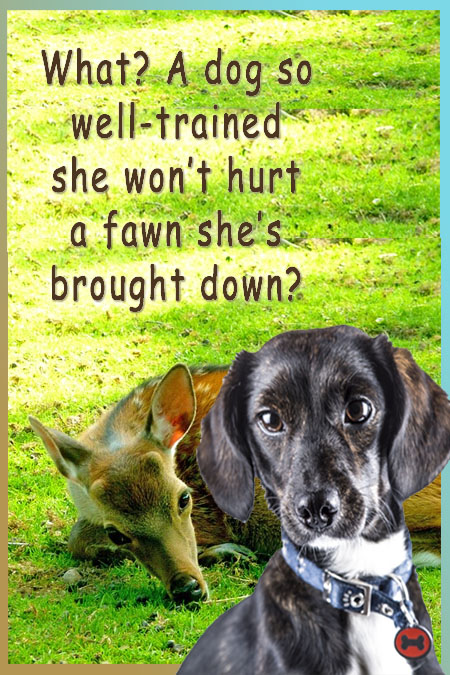You hear a fawn screaming like a baby. Stepping outside, you find your dog hovering over it poised for the kill. What dog commands can you use that will overcome your dog’s natural killer instinct?
Back in the early ’70s our black Dalmation/Doberman cross, Cory, lived with my husband and me out in the country. We had acquired part of the old Devil’s Gulch Ranch in Marin County, California, when it was divided up. We had another dog with us too, a cute little German Shorthaired Pointer named T-Bone.
 Dobermans are considered one of the smartest dog breeds, and Dalmations are quite intelligent, too. Cory had the best of both. Though no match for T-Bone when it came to pointing at birds, in every other respect she beat him hands-down in intelligence.
Dobermans are considered one of the smartest dog breeds, and Dalmations are quite intelligent, too. Cory had the best of both. Though no match for T-Bone when it came to pointing at birds, in every other respect she beat him hands-down in intelligence.
She had been with us for a couple of years. We had trained her as a pup to come and heel and stay out of the street. It was easy, because she learned fast. (We could have trained her to do much more had I read Brandon McMillan’s Lucky Dog—Lessons to Train Your Dog in 7 Days. But it hadn’t been written yet.)
In addition to being one the most energetic and smartest dog breeds around, Dobermans make wonderful pets. And Dalmations are renowned for their perky personalities and unquestioning loyalty. Cory was smart, perky, and incredibly loyal.
And she loved the woods. After we moved to the country she loved being out on the trail with us.
Sometimes, walking along a trail, Hal or I would ask, “Where’s Cory?” Looking around, we wouldn’t see her. Why? She was too close! Right down there between my legs and his, totally unobtrusive.
And she wasn’t a little dog.
One day, hanging out at the ranch while Hal was away on business, I heard a cry. It sounded for all the world like the cry of a baby. Since we didn’t have any babies in our valley, I wondered who it could be.
Stepping outside, I was horrified to find Cory standing over the prone body of a fallen fawn as it bawled for its life.
What to do? Would she come if I called her off? Had she hurt the fawn? I didn’t know.
I called out to her sharply. “Cory, come here, NOW!”
It may have been the desperation in my voice that broke through her intense focus on her prey. She turned her head and looked up at me, and I called her again.
She looked at me, head held high, eyes wild and alert. Then something clicked in her brain—her connection to me, the training we’d done over the last two years, kicked in. Her eyes were still alive with the thrill of the hunt when she dropped her stance, turned away from the fawn with one last look of longing, and walked over to me.
The little fawn scrambled to its feet, unharmed. After looking around in confusion and disbelief, it bounded away.
I was shaken, to say the least, and shocked. Shocked that my dog had responded so well! Trembling, I bent down to hug her and congratulate her for her quick response.
She had certainly done what she had been trained to do. She had come when called, even at a moment when I would have expected her animal instincts to predominate.
Would your dog respond as well in a similar situation? For example, if drawn into a fight, would he come when you called?
 Here are some dog training tips for making sure your dog will return to you whenever you call:
Here are some dog training tips for making sure your dog will return to you whenever you call:
- Don’t vary your dog commands. Use the same word for any desired response every time, whether it be for cinner, a tasty treat, or to play fetch.
- Reward your dog for responding to your commands. (I’ve found that affection works as well as treats.) Then, every time you call, your dog will anticipate a positive experience. Then, even if instinct says “don’t go,” love is likely to win out.
- “If you and your pooch haven’t been on a hike in a while and you decide to take one, do some remedial training first. Help your dog remember the skills that have grown rusty in disuse.
Truth be told, I wasn’t up on training tactics and dog commands back when Cory was alive. But when I wanted our dogs to come, I called them by name and said “Come here!” So there was that consistency, no matter how unconscious on my part. And I’m sure the tone of my voice played a part in bringing her off that fawn. She knew I loved her, and I will maintain to my dying day that she loved me as well.
Whether your dog is one of the smartest dog breeds or just lovable and sweet, good basic training is essential to protect her from harm and to keep her from doing damage to others or to property. You’ve likely seen Brandon McMillan’s Lucky Dog TV show, so you know how kind, gentle, and effective his training is. Let him show you fast, easy ways to get your dog training done.
 Pawsitively,
Pawsitively,
Chiwah Carol Slater
The Pet Story Passionista
Founder, PetWrites.com, AWriteToKnow.com
Support: email us at support@petwrites.com
NOTE: This post may contain affiliate links, and (at no cost to you) I may receive a small commission on your purchase. For example, as an Amazon Associate I earn from qualifying purchases.
